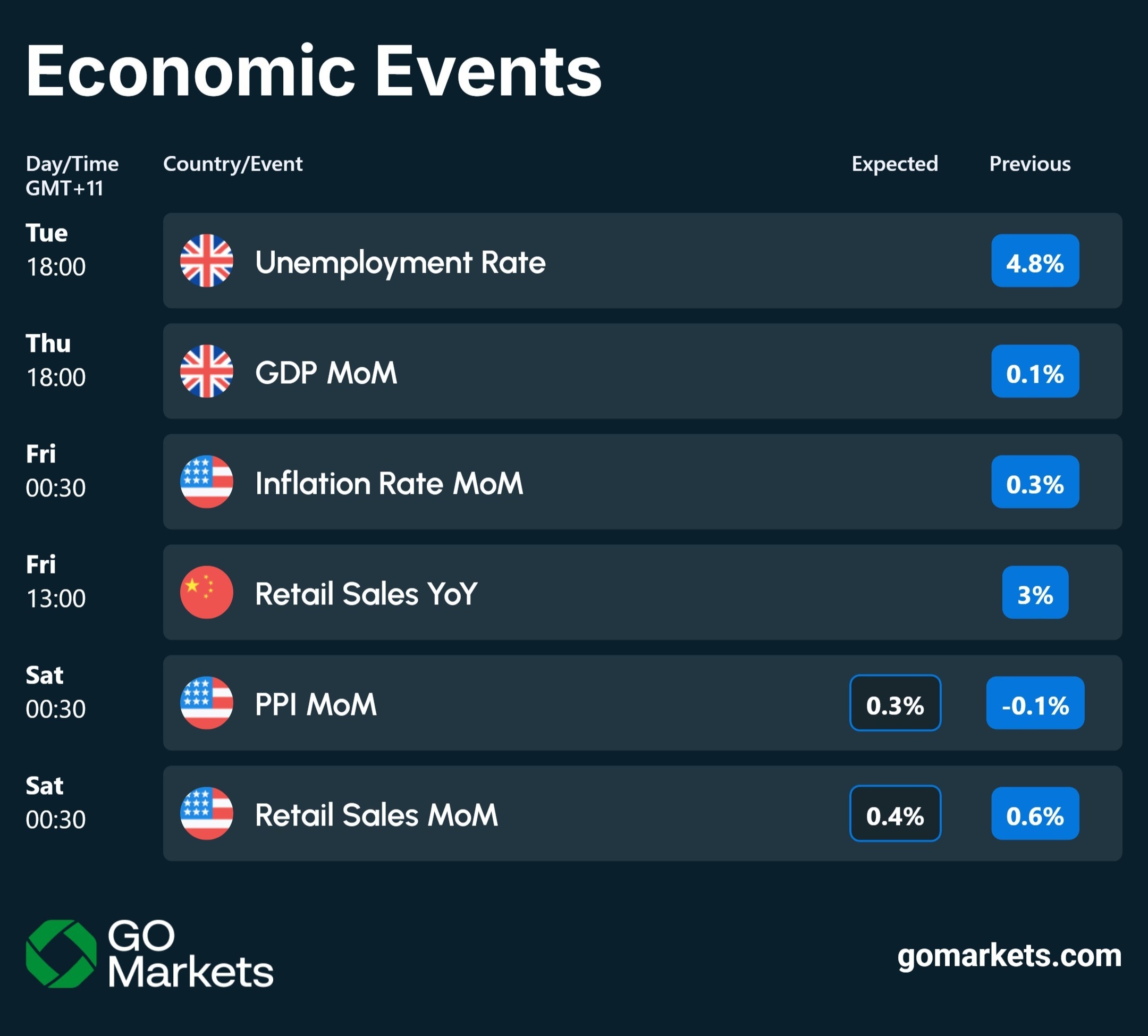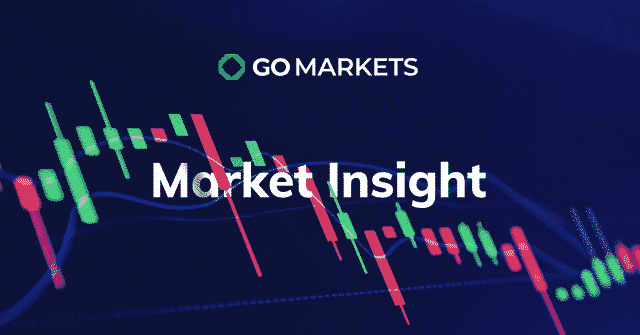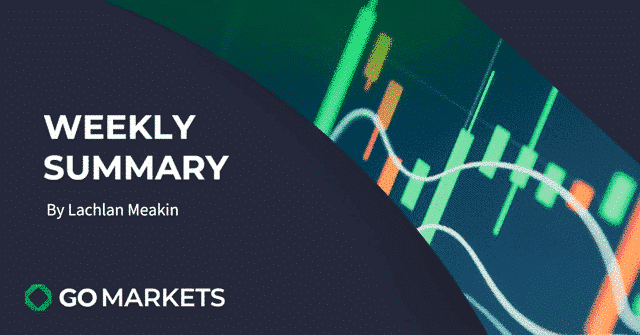市場新聞與洞察
透過專家洞察、新聞與技術分析,助你領先市場,制定交易決策。

Markets retreated last week, pulling back about 2.5-3% from record levels. While the decline is modest, it is marked by several headwinds that could create further pressure this week.
Government Shutdown Reaches Historic Length
The ongoing shutdown has now reached record duration, and there's still no clear resolution in sight. Healthcare remains the primary sticking point between the two sides. Some reports suggest potential progress, but the jury's still out on whether any deal will materialise or gain bipartisan support before the Thanksgiving holiday season.
Key Economic Data May Be Delayed
The shutdown's impact extends to data releases. Market-influencing government reports, including jobs numbers and CPI data, may be delayed this week — CPI is still technically scheduled, but the shutdown could affect its release. This data delay will make it harder to gauge the economy's true direction and could inject further volatility into markets.
Earnings Season Continues to Impress
Despite these macro headwinds, corporate America is delivering exceptional results. We're seeing an 82% EPS beat rate and 77% of companies exceeding revenue expectations. While we're in the final 10% of S&P 500 reports, some important retail stocks are still due. These consumer-facing companies could provide valuable insights into spending patterns and economic health.
NVIDIA Tests Critical Support Level
AI stocks are facing pressure, with NVIDIA testing a key technical level around $180-$185. The stock experienced five consecutive days of losses before bouncing strongly on Friday with a major wick rejection. If support at $180 breaks, we could see a drop to $165. However, Friday's bounce suggests a possible retest of $193. This is a crucial moment for the AI sector leader, and its direction could influence broader tech sentiment.
Market Insights
Watch the latest video from Mike Smith for the week ahead in markets.
Key economic events
Keep up to date with the upcoming economic events for the week.



Global indices ended the week on a high as the US indices all recovered some of their recent sell offs. The Nasdaq was the strongest performer rising 2.05% to close the week. For the week, the index was able to recover some of its recent selling, finishing up 8.18%.
It was also the Technology sector's best week since November 2020. However, it is still down 14.34% from its all-time high. The S&P 500 was up 1.17% and the Dow Jones 0.80% as Wall Street consolidated its gains.
In Europe, the markets were a little weaker, with the DAX finishing flat up 0.17% and the FTSE slightly better up 0.26%. Commodity prices continued to taper as the economic ramifications of the Russian and Ukraine conflict remain steady. Gold has settled at near support at 1900 USD per ounce and the price closed the week at 1920 USD as it holds that level.
Natural Gas continues to hold near its highs finishing the week down 0.54% as it remains in a tight range. Brent Crude Oil followed a similar pattern ending the week just below $108 at 107.96 after bouncing off the low at $97. The price spiked on the back of an escalation of hostilities in Yemen, as Houthi Rebels unleashed an assault on Saudi Arabia’s critical energy facilities.
Previously, a sophisticated strike in 2019 on Aramarco (The world’s largest oil company) facilities took out half of Saudi Arabia’s oil production. The UAE and Saudi Arabia have also so far resisted calls to increase oil production to offset the deficit from the embargo on Russia. FOREX The JPY was pummelled against other currencies as it hit its lowest levels in 4 years against the AUD dropping 3.26% for the week.
Against the USD, the JPY saw its lowest value in 6 years dropping 1.62%. The AUD has continued to be a great performer, with the AUD/USD rising 0.51% as it holds 0.7408 cents. The market will be looking forward to Reserve Bank of Australia Governor Phillip Lowe’s speech on Tuesday for an indication of the likely monetary policy for April.
The AUD has performed well during recent volatility relative to other global currencies due to high commodity prices which have supported the AUD. The EUR/USD and GBP/USD both have been following a steady pattern as Ukraine and Russian conflict has settled. Both pairs remain below their recent resistance.


Australians have been hit with a massive spike in gas and electricity bills as the country deals with a sudden shortage in power. Electricity prices were soaring so high and fast that the energy regulator had to step in and place a cap on the price of energy at $40 a gigajoule until 10 June 2022. Causes of the Crisis The supply shock has been caused by a perfect storm of factors.
A cold freeze and a supply shortage of coal, among a volatile global market which has led to the increase in prices. Adding to this, one of the country’s largest energy suppliers Origin Energy, (ORG) announced earlier in the week that it would not be able to source enough black coal to run the country’s largest plant to full capacity and the problem is not set to ease any time soon. Australia has a large supply of coal and gas; however, it is a net exporter meaning that it sells most of the commodity overseas.
Therefore, as prices rise, the cost to produce electricity within the country increases as well. As coal stations age they fail more regularly, and Australia has an older generation of coal plants. In addition, the transition towards green energy has accelerated the closure of many of the plants.
In response the coal crisis some of the energy producers have increased their production of energy by using gas. However, similar issues apply, in that the country exports a large amount of gas meaning to supply the market, gas must be bought on the international market at international prices. Consequently, the pressures affecting much of the international market now affect Australians too.
This is mainly from supply chain issues relating to the Russia and Ukraine crisis. Government Response The Australian government can apply the Domestic Gas Security Mechanism to reserve more of the export supply for domestic use. The mechanism was introduced in 2017 under Malcom Turnbull for situations exactly like this.
The new Minister for climate change and Energy, Chris Bowen, left all options on the table stating that “action is necessary, and action is being taken.” The price of natural gas is currently sitting at decade highs. The price globally has largely been influenced by the Russian and Ukraine crisis as countries have scrambled to secure gas supplies. Concern for Manufacturers The concern for businesses and manufacturers is paramount.
The concern for businesses is that manufacturers may be hit hard with the increase in these costs. Furthermore, it is difficult for large manufacturers to adjust their contracts to include the additional costs. The economic cost may be felt as reduction in staff may be needed.
The short-term future for the energy market in Australia looks to remain volatile, especially as the country heads into winter. As the government finds ways to deal with the crisis, relief may be on its way.


Coal and Gas prices have surged and joined gold and oil as demand surges due to the supply shortages stemming from the Russia and Ukraine conflict. The global indices were up overall as the market still remains unsure of how to react to the unfolding crisis. In Europe, the FTSE provided strength with a 1.36% gain and the DAX provided a small bounce rising 0.69%.
In America the Dow Jones and the NASDAQ both saw decent rises, moving 1.79% and 1.62% respectively. The US markets responded positively after Jerome Powell testified that the Federal Reserve still intends to increase interest rates later this month by 25 basis points. Mr.
Powell did, however, allow for some flexibility in the face of the increased conflict. The biggest mover was coal which shot up almost 33% to $400 on the back of the energy crisis. It has led to many countries attempting to scavenge for coal reserves.
Germany is poised to create coal power reserves and Italy announced it may reopen some of its previously shut coal plants. The Aussie dollar has benefited from this and other rises in commodity prices with AUDUSD touching on 0.73c overnight. Oil prices reached as high as $114.00 and touched the 8 year high before settling in at $111.
This is after OPEC decided overnight to hold production level at the current level leaving the potential shortfall in demand unaccounted for, claiming that that demand for oil is being driven by geopolitics and not fundamentals. The price of wheat and aluminium also hit 14-year highs overnight and Gold continues to remain steady at $1,927 per ounce. Bitcoin saw a slight slump and is down 1.47% although is still very much moving upward due to the momentum from Russian investors.
The Ruble saw some strength as it saw upward of 5% gains against many other currency pairs. The US dollar continues to be strong on the back of the Federal reserve and from the risk aversion seen in the market at the moment.


Equity markets US stocks jumped overnight to reach record levels as stronger than expected print on retail sales and a sharp improvement in the number of new jobless claims cheered the investors. Source: Yahoo Finance US reporting season kicked off this week with impressive results so far from Finance heavyweights JP Morgan, Goldman, BOA and Citi, all handily beating estimates. The week's economic figures, strong corporate earnings and comments from Fed Chairman Powell regarding the commitment of the central bank's easy money policies have seen US markets make all time highs on an almost daily basis.
European stocks also hit record highs this week with the EUROSTOXX 50 breaking 4000 and having rallied nearly 80% from the pandemic lows in March 2020. Analysts are confident there is further upside in Europe as prices remain low compared to the U.S and vaccination rates climb to catch up to the U.S. “European equities are set to benefit from a sharp acceleration in euro area GDP (gross domestic product) growth over the coming months, but that is due to the boost from reopening and the support from a powerful U.S. recovery, rather than a function of the dispersal of NGEU funds,” two analysts at Bank of America said in a note to clients. World equity indices are mostly up for the week with only Asian indices lagging.
Traders will be watching today's upcoming Chinese figures, including the all-important GDP figure, which is expected to be the highest quarterly economic growth since it began releasing such figures 30 years ago. Source: Bloomberg Forex markets The US dollar weakened dramatically during the week, under performing all major currencies bar the Canadian dollar. Despite a strong week in Oil, current COVID lock down measures in Canada are causing a headwind for the Loonie.
Source: Bloomberg The recent run up in the US dollar index in tandem with rising 10 year bond yields has reversed in April as yields stabilise and are starting to decline. Overnight 10 year Treasury yields dropped to 1.57%, its lowest level in a month. Source: Bloomberg Source: GO MT4 Commodities Gold Spot gold (XAUUSD) rallied this week on the back of a weaker US dollar.
US CPI figures also came in higher than expected this week, giving gold an extra boost as it is seen as a traditional inflation hedge. Source: GO MT4 Oil US crude prices rallied strongly this week on continued expectation of a global economic recovery. Agreed production cuts have also given Oil a boost as OPEC is holding back just over 7 million barrels per day, with Saudi Arabia voluntarily cutting an additional 1 million barrels per day.
From next month OPEC+ will start gradually curbing production cuts. In May OPEC+ will allow an additional 350,000 barrels per day to join the markets. Source: GO MT4 Bitcoin The highly anticipated Coin base (COIN) IPO launched this week, with investors piling into the new stock.
This mainstreaming of cryptocurrencies in general and Bitcoin in particular saw strong buying in Bitcoin pushing it through the 60k resistance level and hitting all time highs just short of $65k USD. Source: GO MT4 Monday, 19 April 2021 Indicative Index Dividends Dividends are in Points ASX200 WS30 US500 US2000 NDX100 CAC40 STOXX50 0 0 0 0.005 0 2.808 1.234 ESP35 ITA40 FTSE100 DAX30 HK50 JP225 INDIA50 0 79.017 0 0 0 0 0


The market closed the week down overall as volatility continues due to the Russia and Ukraine conflict. The Dow Jones dipped 0.5%, the S&P500 fell 0.8%, and the NASDAQ performed the worst, declining 1.7%, despite generally positive sentiment from the USA concerning the employment figures released on Friday. Employers added 678,000 jobs to the workforce in February, and unemployment was lowered to 3.8% beating most analysts' expectations.
CPI figures will be on the agenda next week as inflation continues to garner attention. European stocks were hit the hardest, with the DAX losing more than 10% over the week and 4.41% on Friday, as it continues to be hit hard by the conflict. The FTSE also had a tough week and closed Friday down 3.48%.
Commodities had a belter week and got close to their largest rise in prices since 1960. European natural gas more than doubled in price, wheat soared 40%, and oil increased 20%. These increases may have an impact on the energy and commodity sector in the Australian market going forward.
The surge in energy prices has occurred despite economic sanctions that have not targeted Russia’s energy exports. Gold finished the week exceptionally strong, closing at the upper end of the weekly range towards $1,970. The price continues to provide a haven for investors as the volatility remains.
Oil followed its strong closing towards the high of the week at $117.96. Cryptocurrency Bitcoin had shown strength earlier in the week, but it could not hold its highs around $45,000 BTC/USD. It closed the week below $40,000.
Ethereum followed a similar pattern falling to $2,593. FOREX The EUR/USD had a massive drop falling -1.23%. The Euro struggled against all of the currency pairs, recording big drops for the week.
The GBP also was a weak performer for the week. Due to their geographical exposure, the EUR and GBP have been the most sensitive to news from the conflict. The AUD and NZD performed well for the week and have seen a nice move into recent resistance.


Blackstone Minerals Limited’s Ta Khoa project is drumming up a lot of interest among banks and analysts who have recently taken a tour of the site. Among the tour group lies Vietnamese’s largest conglomerate, Vingroup. Vingroup has interests in real estate, automotive industry, healthcare and other sectors with a combined market capitalization of $32 billion USD.
Experts believe that Vingroup’s goal is to obtain any and all of Blackstone’s nickel processed from Ta Khoa. Ta Khoa is a large-scale underground nickel mine located in the Son La Province in northern Vietnam. It was put under ‘care and maintenance’ (a term for a mine site that is closed and is scheduled to be reopened at a later date) in 2016 as there were challenges from depleting resources and low nickel prices.
Blackstone would welcome discussions with Vingroup about an agreement and potential associated funding deals. This is because Blackstone and Vingroup would have the common interest of launching a big project off the ground. Both companies would have the same capital requirements and need for funding.
Blackstone is currently listed on the ASX with a $125 million market cap, their share price opened at 29.5 cents this morning, this was an increase of 13% compared to Friday’s closing price of 26 cents. Blackstone is looking to develop a Vietnamese integrated mining and refining battery metals processing business, this is why they own 90% of Ta Kong. Vingroup would be a suitable partner for the Ta Khoa project as they are Vietnam’s biggest employer.
According to Mvis-Indices, Vingroup makes up about 10% of the VN-Index. They also have a considerable interest in vehicles, with their subsidiaries Vinfast and Vinbus. Vinfast produces cars and motorbikes and they have planned on ceasing the production of internal combustion engines cars by the end of 2022.
They would put more focus on electric vehicles as they’ve sold their first batch in 2021. Nickel is a crucial component of electric vehicles. If you would like to trade Blackstone Mineral shares and don’t already have a trading account, you can register for a Shares trading account at GO Markets.
Source: ASX, Blackstoneminerals, Vingroup, Nsenergybusiness, Wikipedia, Mvis, Tradingview, AFR.

